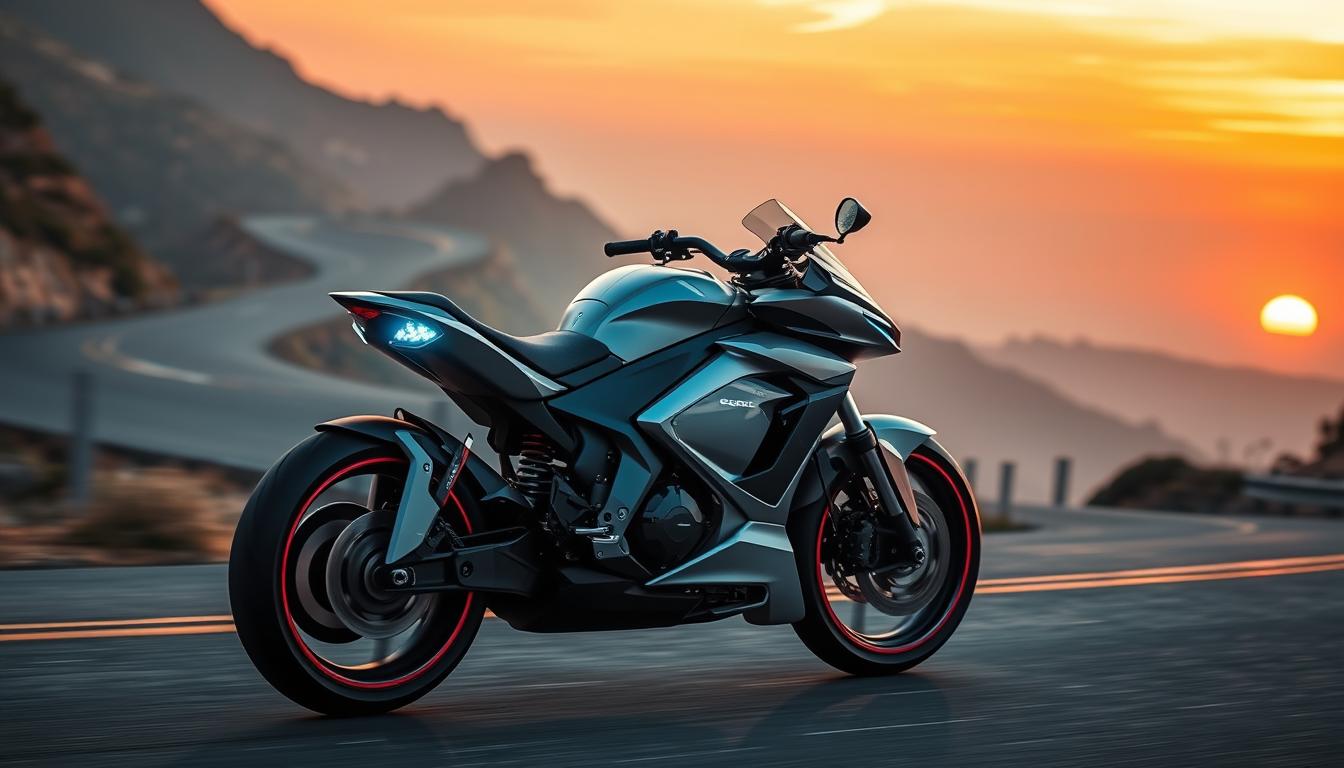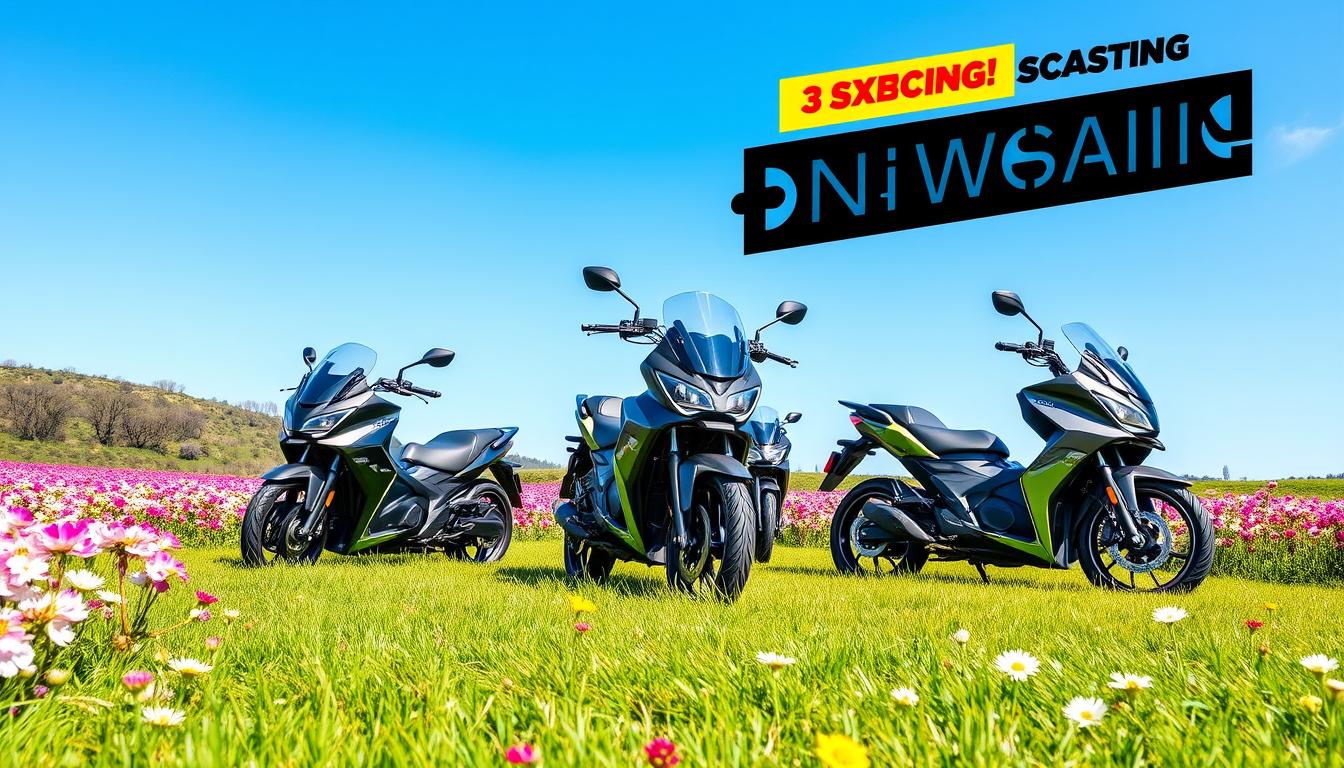Did you know electric motorcycle conversions can cost between $2,800 and $7,000? Electric bikes are getting more popular. People are looking into Electric Motorcycle Starter Kits to go green and enjoy the ride. These kits make switching from gas to electric easy.
These kits are great for DIY fans and newbies. You can choose from fast bikes like the Yamaha FJ1100 or tough ones like the Kawasaki 750 Ninja. A complete kit has everything you need for a smooth switch. Start your electric motorcycling journey with a starter kit here.
Choosing an Electric motorcycle conversion kit means more than just a product. It’s a step towards a future where being green and mobile go hand in hand. Are you ready to learn more about these starter kits? Let’s explore what it means to convert your bike.
Key Takeaways
- Electric Motorcycle Starter Kits make conversion accessible for beginners.
- Average conversion costs can range from $2,800 to $7,000.
- These kits often include all essentials for a complete electric motorcycle transformation.
- Converting offers eco-friendly benefits alongside significant cost savings.
- Many models, such as the Yamaha FJ1100, can achieve impressive top speeds and ranges after conversion.
Introduction to Electric Motorcycle Conversion
The motorcycle world is changing, with more people choosing electric bikes. They want to make their old bikes green and powerful. Electric bikes are better for the planet, making less pollution than gas bikes.
Starting a DIY electric bike project is exciting and good for the planet. You can make it your own, blending style with green tech. But, it’s a big job that needs careful planning and tech skills.
“An electric motorcycle not only helps the environment but also satisfies the inner engineer in you as you navigate your conversion project.”
Building an electric bike costs a lot, from $3,000 to $10,000 or more. The price depends on what parts you choose and how hard the job is. Also, you might need to follow the same rules as gas bikes, like getting a license.
There are great resources online, like forums for mechanics. You can also find detailed guides, like this step-by-step tutorial. Join the electric bike movement and ride into a greener future.
Understanding Electric Motorcycle Starter Kits
Electric motorcycle starter kits have changed how people enjoy motorcycling. They let you turn your old bike into an electric one. These kits come with key parts like the motor, controller, battery, and wiring.
Looking around, you’ll see many electric motorcycle starter kits. Some fit certain models well, while others are more flexible. Knowing what each kit offers helps you pick the right one for your bike.
When picking a kit, check if it fits your bike. Some kits work for many bikes, while others are made for specific ones. A good complete electric motorcycle kit makes the conversion easy and fun.
The beauty of electric motorcycle starter kits is how easy they make things. They help you switch to cleaner energy. As electric starters become more common, they’re key in the world of motorcycles today.
Component |
Description |
Importance |
Electric Motor |
Powers the motorcycle, typically robust and reliable. |
Core of electric propulsion. |
Controller |
Regulates power flow to the motor. |
Essential for managing speed and torque. |
Battery Pack |
Stores energy for the motor to function. |
Determines range and overall performance. |
Wiring Harness |
Connects all electrical components. |
Ensures proper power distribution. |
Benefits of Converting to Electric Motorcycles
Switching to an electric motorcycle brings many benefits. It makes your rides better and helps the planet. You’ll save money too.
Eco-Friendliness and Sustainability
Electric motorcycles are great for the environment. They’re quieter than gas bikes, cutting down on noise pollution. By choosing electric, you help reduce carbon emissions.
They also offer a smoother ride. This makes your journey more comfortable and keeps the peace around you.
Cost Savings on Fuel and Maintenance
Electric bikes are cheaper to run over time. They cost less to fuel and need less upkeep. This means you save money every day.
They also come with other perks. You might pay less for insurance, tolls, and parking. These benefits make electric bikes a smart choice for daily rides.
Essential Components of an Electric Motorcycle Conversion Kit
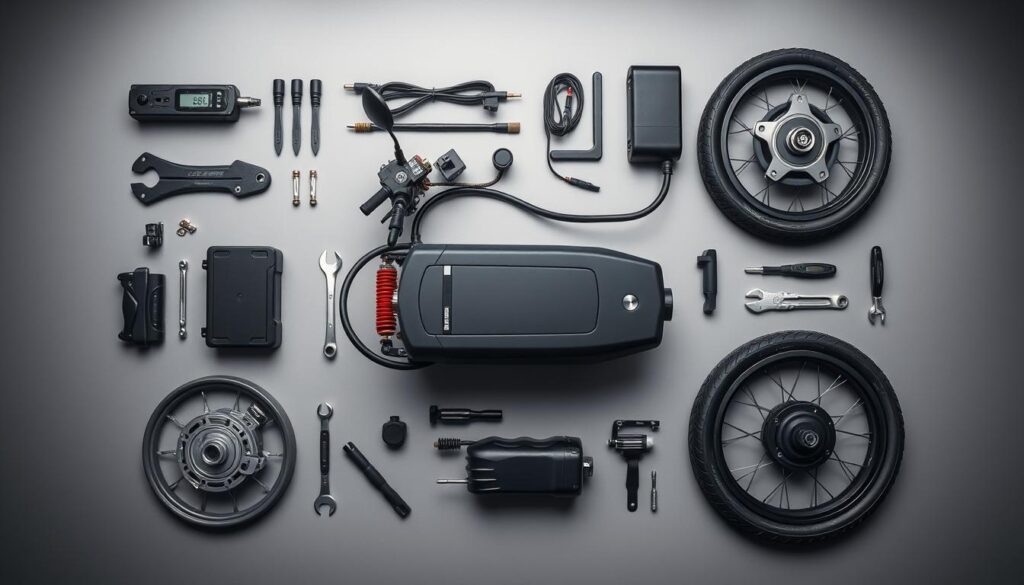
Starting an electric motorcycle conversion means knowing the key parts needed. This part talks about the important things like electric motors, controllers, and battery sizes. Each part is crucial for a successful and reliable conversion.
Electric Motor Options
Choosing the right electric motor is key for your motorcycle’s performance. There are many electric motor options, each for different conversions. For example, brushless motors are efficient and reliable, while geared hub motors have high torque.
Brands like Zero Motorcycles offer complete systems. These can greatly improve your motorcycle’s performance.
Controllers and Their Role
The controller is the brain of your electric motorcycle. It controls the power flow from the battery to the motor. Pick a controller that fits your motor’s needs for the best performance.
High-quality controllers, like those from Kelly Controls, have features like regenerative braking. They also let you customize settings. This ensures your electric motorcycle runs smoothly and efficiently.
Batteries: Types and Sizing
Battery choices affect your electric motorcycle’s range and performance. Lithium-ion batteries, like those in the Electric Motorsport GPR-S conversion, are popular. They are known for their energy density and long life.
Choosing the right battery size is important. Make sure it matches your energy use, about 100 Whr/mi. This way, you get the range you need without slowing down your system.
In conclusion, picking the right parts for your electric motorcycle conversion is crucial. By carefully choosing your electric motor, controller, and battery, you’ll get a reliable and efficient electric motorcycle. It will meet your specific needs.
Electric Motorcycle Starter Kits | Everything You Need in One Package
Thinking of turning a motorcycle electric? You’ll need the right tools and parts. Starter kits for electric motorcycles offer a full solution. They come with everything you need for different models, making your conversion easy.
These kits have key parts like wiring, motors, controllers, and batteries. They’re made for your motorcycle, with clear instructions. This makes DIY conversions faster and less likely to go wrong.
The Ark Racing Limited kit is great for BSA unit twins. It includes a new case, belt drive, Denso starter motor, and wiring. It makes starting your bike easy and improves shifting.
- High-quality components for reliability and performance
- Compatibility with multiple motorcycle models
- Step-by-step installation instructions included
- Access to customer support for personalized solutions
These kits are available from Shropshire Classics. For more info, contact Ark Racing directly.
Feature |
BSA Electric Starter Motor Kit |
Triumph Electric Starter Motor Kit |
Motor Type |
Denso starter motor |
Denso starter motor |
Includes Case |
Yes |
Yes |
Clutch Shock Absorber |
Included |
Included |
Contact for Pricing |
Shropshire Classics |
Shropshire Classics |
Personalized Solutions |
Available |
Available |
Choosing a complete electric motorcycle kit makes your project easier. It also improves your ride, embracing electric’s future.
Choosing the Right Motorcycle for Conversion
Choosing the right motorcycle is key for a successful electric conversion. You need to look at factors like frame durability, weight, and engine condition. A bike that meets these criteria will make the switch to electric easier.
Finding a Suitable Donor Motorcycle
Start by finding the right donor motorcycle. Look for older models that are easy to work with. Here are some good options:
- Honda CB series
- Kawasaki KZ models
- Yamaha XS series
These bikes are strong and have room for electric parts. They’re also light, which helps with electric efficiency.
Considerations for Size and Frame
The size and frame of the motorcycle matter a lot. Make sure to check these things:
- Frame Strength: The frame must hold the weight of the electric motor and batteries.
- Weight Distribution: A balanced bike is stable and easy to ride. Aim for a low center of gravity.
- Size Compatibility: Make sure there’s enough room for the motor and batteries. This makes installation easier.
Most motorcycles weigh around 700 lbs. You need to consider the total weight of bike and rider. This ensures a safe and fun ride after the conversion.
Steps for Converting Your Motorcycle to Electric
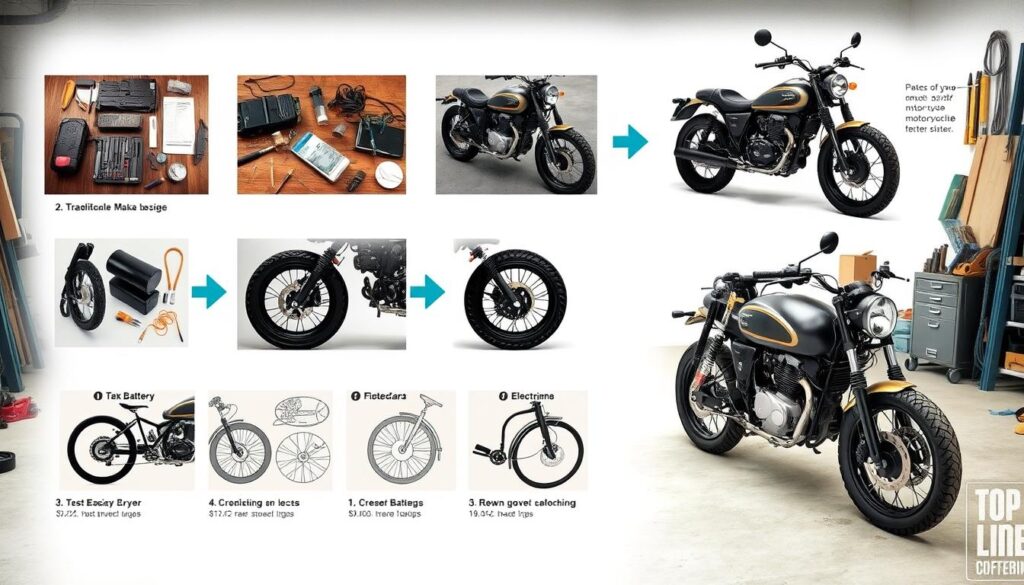
Starting an electric motorcycle conversion needs careful planning. It’s important to know the key steps before you begin. Here’s how to get your motorcycle ready and install the electric parts.
Initial Research and Planning
First, do thorough research. Look at other people’s experiences, both good and bad. This helps you understand what to expect and how to plan your project. Know what parts you need, like the QS Motor 17×1.6inch 2000W 260 35H V1.12 In-Wheel Hub Motor. Choose wisely based on your power needs and bike type.
Gut and Clean the Frame
Preparing the motorcycle frame is crucial. Start by taking out the old engine and parts you won’t need. Clean the frame well to remove dirt, rust, or anything that could harm the new electric system. This makes your bike look better and helps your new parts last longer.
Design and Mounting Components
Plan how you’ll arrange your electric motorcycle’s parts. Think about where to put the motor and battery for balance. Mount the QS Motor carefully to fit the frame right. Use a 2011-2015 Hyundai Sonata battery in a 2s4p setup for 60V and 21Ah. Good planning makes installation easier and improves how your bike performs.
Component |
Specification |
Motor |
QS Motor 17×1.6inch 2000W 260 35H V1.12 In-Wheel Hub Motor |
Battery |
Hyundai Sonata (2011–2015) battery using 2s4p configuration |
Voltage |
60V |
Capacity |
21Ah |
Range Expectation |
125 miles on a single charge |
Detailed Overview of Electric Motorcycle Components
Understanding the key parts of an electric motorcycle is essential. You’ll find different motors, controllers, and battery types. Each affects how well your motorcycle performs and how efficient it is. This section will guide you through these components, helping you choose the right ones for your project.
Types of Electric Motors
There are many motor types for electric bikes, each with its own benefits. Here are some of the most common:
- Brushless DC Motors (BLDC): These motors are efficient and long-lasting. They have strong torque and need little upkeep.
- Hub Motors: Built into the wheel, hub motors are easy to install and light. But, they might not perform as well on steep hills.
- AC Motors: AC motors deliver power well and can go fast. They’re great for bikes that need high speed.
Choosing the Right Controller
The motor controller is crucial for your electric bike’s performance. It controls the power from the battery to the motor. When picking a controller, think about:
- Voltage Range: Make sure the controller fits your battery’s voltage. Batteries usually have 36V or 48V, but can go up to 72V.
- Current Rating: Choose a controller that can handle your motor’s current needs. This depends on how fast you want your bike to go.
- Features: Some controllers have cool features like regenerative braking. This helps your battery last longer.
Understanding Battery Chemistry
Battery chemistry greatly affects how well your battery works and lasts. Most electric bikes use lithium-ion batteries. They offer big advantages:
- Weight and Power: Lithium batteries are lighter and pack more power than older types like lead-acid or Nickel Cadmium.
- Cell Quality: Choose high-quality cells, like 18650 or 21700 from brands like Panasonic and Samsung. They’re reliable.
- Capacity Ratings: Battery sizes for electric bikes range from 300 to 800 watt-hours. The right size depends on your bike’s needs.
Installation: Mounting the Electric Motor and Batteries
Starting your electric motorcycle conversion is a big step. This phase is all about careful planning and precise work. You’ll need to focus on installing the electric motor and mounting the batteries right. Getting this part done well is key for your bike’s performance and safety.
To install the electric motor, pick a spot in your motorcycle’s frame first. Make sure the motor is balanced and stable. Think about these things:
- Weight Distribution: Spread the weight evenly to improve handling.
- Accessibility: Choose a spot that’s easy to get to for upkeep.
- Clearance: Make sure there’s enough room for all moving parts.
How you mount the batteries is also important. They need to be held tight with the right brackets to stay in place while you ride. Here are some tips for mounting batteries well:
- Low Center of Gravity: Put batteries low in the frame for better balance.
- Vibration Dampening: Use padding or special mounts to reduce battery vibrations.
- Connectivity: Place batteries where wiring and connections are easy to reach.
Before you’re done, check everything is aligned and connected right. Well-mounted parts mean a smoother ride and better performance for your electric bike. Take your time to make sure your setup is the best it can be.
Wiring and Electrical Configurations
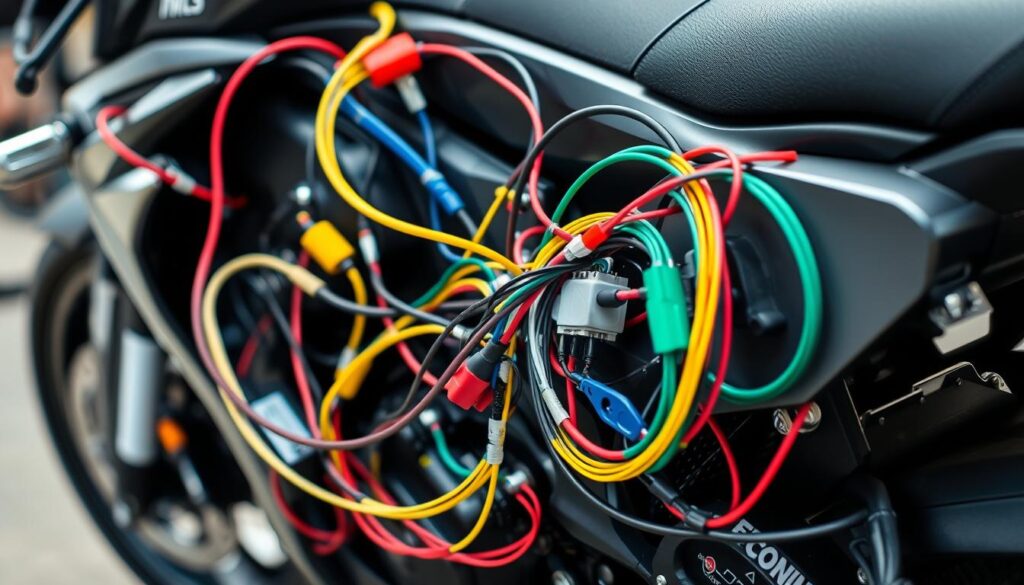
Converting your motorcycle to electric starts with wiring. It’s key for both performance and safety. We’ll cover the steps and safety tips for a smooth conversion.
Safety Precautions While Wiring
Wiring safety is crucial. Here are important steps to follow:
- Use high-quality tools for clean connections and avoid shorts.
- Wear safety goggles when cutting or stripping wires.
- Be careful with battery acid and wear gloves.
- Don’t rush. Plan and do each step carefully.
Grounding issues can be dangerous. Always check connections and make sure they’re secure.
Getting the Right Wire Gauge
Choosing the right wire gauge is vital. The gauge size affects your electric motorcycle’s performance and safety. Consider these factors:
- How much current each part will use.
- The wire’s length. Longer wires need thicker wire to avoid voltage drop.
Here’s a table to help pick the right wire gauge:
Current (Amperes) |
Wire Gauge (AWG) |
Maximum Distance (feet) |
0-10 |
18 |
50 |
10-20 |
16 |
40 |
20-30 |
14 |
30 |
30-40 |
12 |
20 |
Knowing about wire gauge and following safety tips will help you create a reliable electric motorcycle system.
Test and Troubleshooting After Conversion
After converting your motorcycle to electric, it’s key to do a thorough test. Make sure all parts work right in different situations. Finding common problems and checking everything step by step can make troubleshooting easier.
Common Issues and Solutions
When you start testing, you might run into some issues. Knowing these problems and how to fix them can make troubleshooting better. Here are some common problems you might face:
- Motor Functionality: The motor might stop and start too often. This usually happens after 10-20 seconds. Check the connections and make sure everything is tight to fix this.
- Battery Efficiency: If the battery charge drops unexpectedly, it’s a sign of a problem. Losing two bars of charge on a 1.5-mile ride is a red flag. The battery should read between 12.5 – 12.9 DC volts when not in use and 13.5-14.5 volts when running. Over 15 volts can mean overcharging.
- Vibrations in the Front Hub Motor: You might feel vibrations like riding over a washboard. Fixing any misalignments or checking the wheel mounting can solve this.
- Time-Consuming Diagnostics: Some people have to take apart the kit to find problems. Doing organized troubleshooting, like checking Stator coils for continuity, can make this easier.
- Voltage Readings Under Load: If the voltage drops a lot when the motorcycle is working hard, the R/R Unit might be the problem. Regular checks can stop damage to other parts.
Writing down what you find during these tests is helpful for future troubleshooting. It helps track how things improve over time. Having the right tools, like a multimeter, ready will make testing and fixing faster.
Real World Examples of Electric Motorcycle Conversions
Looking into electric motorcycle conversion kits shows us how to change traditional bikes to electric ones. Success stories tell us about the challenges and how to overcome them. We’ll look at two examples: the Yamaha FJ1100 and the Kawasaki 750 Ninja.
Case Study: Yamaha FJ1100
The Yamaha FJ1100 conversion is a great example. It uses a 15KW motor system and has full-function throttles for safety. This bike can go up to 20HP, showing how well it works.
- Motor Weight: 28.5 lbs
- Battery Weight: 30 lbs
- Total Conversion Time: 6-7 weeks
- Estimated Cost: $3,000 – $4,000 (excluding donor bike)
This conversion is impressive, with a motor current draw of 210-250A. It’s a top example of electric motorcycle success.
Case Study: Kawasaki 750 Ninja
The Kawasaki 750 Ninja also got a great makeover. It uses a battery pack of 180-270Wh and 250W/350W geared hub motors. The 7Ah battery model has 20x3500mAh cells for strong power.
Component |
Specifications |
Controller |
250W with a sustained output of 7A at 36V |
Battery Type |
24V, 4.8Ah providing 115Wh |
Range |
60-80 miles with throttle assistance |
Battery Capacity |
Approximately 250Wh |
Conversion Kit Cost |
Less than £300 for enhanced range |
This project shows how to manage power well and keep the bike light. It’s a great example of electric motorcycle conversions. It shows how creative and innovative people can be in this field.
Maintaining Your Electric Motorcycle Post-Conversion
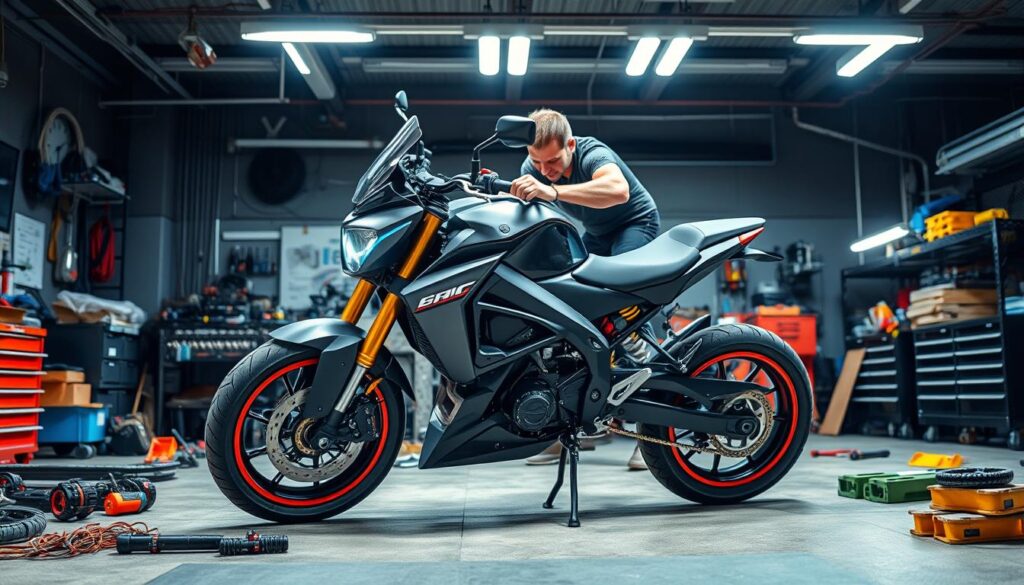
Keeping your electric motorcycle in good shape is key for its long life and best performance. After you’ve converted it, regular maintenance is a must. It helps catch problems early on. Here are some top tips for electric motorcycle care.
Scheduled Maintenance Practices
Having a maintenance schedule is crucial for your electric motorcycle’s health. Important tasks include:
- Regularly check electrical connections and parts to avoid problems.
- Test the system voltage after long rides to make sure it works right.
- Keep an eye on tire pressure and condition for the best ride.
- Make sure the brakes work well, as safety depends on it.
Battery Management and Lifespan
Taking care of your electric motorcycle’s battery is essential. Here’s how to do it:
- Follow the manufacturer’s charging instructions and avoid overcharging.
- Keep batteries in a cool, dry spot to extend their life.
- Check battery health and capacity often, using a smart system if you can.
- Balance battery cells regularly for even charging.
By sticking to these maintenance tips, your electric motorcycle will run better and last longer. Switching to electric is exciting, so it’s important to keep up with good care practices.
Advanced Enhancements for Your Electric Motorcycle
Looking to make your electric motorcycle better? There are many advanced upgrades to choose from. These enhancements boost performance and add features tailored to your needs. Upgrading and adding accessories can make your rides faster and more fun.
Performance Upgrades
Improving your motorcycle’s performance can change your riding experience. A more efficient setup means faster speeds and better handling. For example, a 36V 500W Heinzmann motor can reach up to 35 MPH on flat ground.
This motor uses four Sony VT LiMn batteries for a 36V/8A pack. This setup greatly increases power and range. Here are some key upgrades:
- Battery Enhancements: More powerful batteries mean better range and performance.
- Braking Systems: Avid BB7 brakes or regenerative braking improve safety and efficiency.
- Chain Upgrades: A new KMS Nickel Plated Quick Link Chain boosts power transfer reliability.
- Connector Upgrades: 45A Anderson PowerPole connectors ensure strong battery connections.
Additional Features and Accessories
Adding accessories can make your motorcycle your own. You can choose from simple add-ons or complex systems. Knowing about Watt Hours per Mile and Amp Hours helps optimize your upgrades. Here are some useful accessories:
- Improved Interfaces: Choose displays that show important performance metrics easily.
- Custom Fenders and Lights: Personalize your bike and improve safety with custom fenders and lights.
- Riding Gear: Invest in quality gear for better comfort and safety.
These upgrades can make your motorcycle perform better and feel more personal. Making sure everything works together lets you enjoy your electric motorcycle fully.
Cost Considerations and Budget for Conversion
When planning an electric motorcycle conversion, it’s important to know the costs. You need to think about the parts and labor involved. This helps you plan without spending too much. Here’s how to estimate costs and find affordable parts for a budget-friendly conversion.
Estimating Overall Project Costs
To start your electric motorcycle conversion, first, estimate the total costs. Look at these key components:
- Electric Motor: Prices vary based on power, from $300 to $1,200.
- Batteries: Lithium batteries cost between $500 to $1,500.
- Controller: A good motor controller costs $200 to $500.
- Charger: Quality chargers are around $100 to $300.
- Other Components: Extra parts like wiring and connectors add $100 to $300.
With these costs in mind, a full conversion might cost between $1,300 to $2,700. This depends on your choices and needs.
Finding Affordable Parts and Kits
Finding cheap parts is crucial for a budget-friendly conversion. Look for:
- E-bike conversion kits from brands like BAFANG and Cytronex, which are often cheaper than buying parts separately.
- Online marketplaces and forums for used or discounted parts.
- Local workshops or stores with promotions or second-hand parts.
Also, consider solar panels to boost your bike’s power. Semi-flexible solar panels cost about $2 per watt. Thin-film solar blankets are $5 to $10 per watt. These can improve your bike’s efficiency and range.
Conclusion
Electric motorcycle conversion opens a world of possibilities for riders. It’s great for both new and experienced riders. With careful planning and quality starter kits, you can turn a traditional bike into an electric one.
This change is not only good for the planet but also saves money. You get to enjoy riding without spending too much. It’s a win-win situation.
Choosing to go electric is more than just a change. It shows you care about the environment and want to innovate. It’s a chance to make your dream bike a reality.
Every step you take towards electric is a step towards a greener future. It’s a journey filled with rewards and excitement. Start now and be part of the eco-friendly riding movement.
FAQ
What are electric motorcycle starter kits?
Electric motorcycle starter kits are all-in-one packages. They have everything you need to turn a gas bike into an electric one. These kits make the DIY process easy for both newbies and seasoned riders.
What components are typically included in an electric motorcycle conversion kit?
A typical kit includes an electric motor, a controller, and a battery pack. You’ll also get the wiring and hardware needed. Some kits even offer mounting brackets and step-by-step guides.
What are the advantages of converting my motorcycle to electric?
Going electric means less pollution and noise. It also saves you money on fuel and upkeep. This makes electric bikes a smart choice for getting around.
How do I choose the right motorcycle for conversion?
Look for a bike that’s light, in good shape, and fits the conversion kit. A smaller, lighter bike will likely perform better after the switch.
What types of electric motors are available for motorcycle conversions?
You can choose from hub motors, brushed motors, or brushless DC motors. Pick one based on your bike’s setup and how fast you want it to go.
How can I ensure safety during the wiring process of my electric motorcycle conversion?
Double-check your connections and use the right wire sizes. Avoid grounding problems. Staying safe during wiring is key to your bike’s performance.
What maintenance practices are important for electric motorcycles?
Keep an eye on your battery and make sure everything electrical works right. Regular cleaning is also important. Taking care of your battery is key to its long life.
Can I upgrade my electric motorcycle after conversion?
Absolutely, you can make your electric bike even better. Try new batteries, controllers, or accessories. These upgrades can boost your bike’s speed and looks.

 By
Hamza Shakeel
By
Hamza Shakeel


